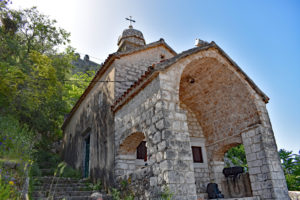The Montenegrin town of Kotor, a UNESCO World Heritage Site, is on the cruise ship route and as it’s only small, the impact is huge. During our stay, the 3,600 passenger MSC Magnifica was berthed. Not being a cruise aficionado, I naively asked our guide how many nights it stayed and discovered it arrived at 7am and departed by 1pm. He told us that the novelty of having the town swamped has not worn off yet, as businesses were making money. However, in time it will follow the lead of its Croatian neighbour, Dubrovnik, who limit ship numbers and choose ships with passengers who spend the most money. Kotor is also a popular day trip by bus from Croatia. In contrast, we were staying for three nights so spread our town visits out to avoid the crowds.
We had a guide for our first full day. Slavko began our tour outside the main gate of the old town, there are two others, with a 15-minute history of Kotor from the Illyrians to the present day. This was peppered with so many facts, figures and dates they were instantly forgotten.
However, on entering the triangular shaped town, things came to life. Although we’d wandered around the town the previous day on our own, Slavko pointed out highlights we’d completely missed: engravings only seen on looking up, things that hadn’t been put back in the right place after the 1979 earthquake, a slit in the wall which would have been full of bees (returning soldiers were expected to put their hand in and the bees were meant to only sting the unfaithful).
The two-faced clock tower was located in the main square, named the Square of Weapons as men had to give them up on entering. However, as they were reluctant to do so, it was generally only women who entered to sell their produce. A shaming post was next to the former prison: here those who had committed a minor crime, were tied to it with a board proclaiming their crime.
A series of narrow streets led us to former palaces of the noblemen which had been taken over when communism was introduced. St Tryphon’s Cathedral was surprisingly empty, possibly due to the €3 entrance fee. Its date of consecration, 1166, and its 850th anniversary were etched on the outside. Upstairs were numerous displays, many of them silver, which had been more valuable than gold, and a balcony had a good view over the square.
Back outside, we saw the maritime museum, churches of St Luke and St Mary and in the maze of narrow alleys, came across a bar with small tables hung from the wall for your glass.
On our second day, we decided to attempt the climb to the Fortress of St Ivan, up 1,350 steps. With daytime temperatures nearing 30 degrees, Slavko had recommended setting out as early as possible. At 8am, we left the old town through the north gate, heading uphill past St Mary’s Church. Eventually we reached the entrance, paid €8 each, negotiated the turnstile and started climbing. The cobbled, winding path had several narrow flights of steps cut from the rock and wildflowers of all colours lined the path. The steps weren’t too difficult, and with long strides we quickly made headway although we needed numerous ‘photo stops’ to catch our breath. We reached the midway point, the locked 16th century Chapel of our Lady of Salvation, which was built by survivors of the plague. The views of the triangular shaped old town and harbour with a mountain backdrop was stunning. We decided to continue further and reached the fortress walls, where the steps appeared to get much steeper. By now it was 9.30am, it was starting to get hot, I was pooped, and knew I still had to get back down again. So, after a rest, we reluctantly turned around having done around 1,000 of the 1,350 steps. Back in the town, our first stop was for a cold, reviving beer.
Kotor is a wonderful atmospheric place with its maze of cobbled streets and fabulous historic buildings, museums and churches. There’s a plethora of bars, restaurants and souvenir shops and it certainly deserves more than half a day. However, we did rather enjoy evenings in the town when it had cooled and calmed down.










